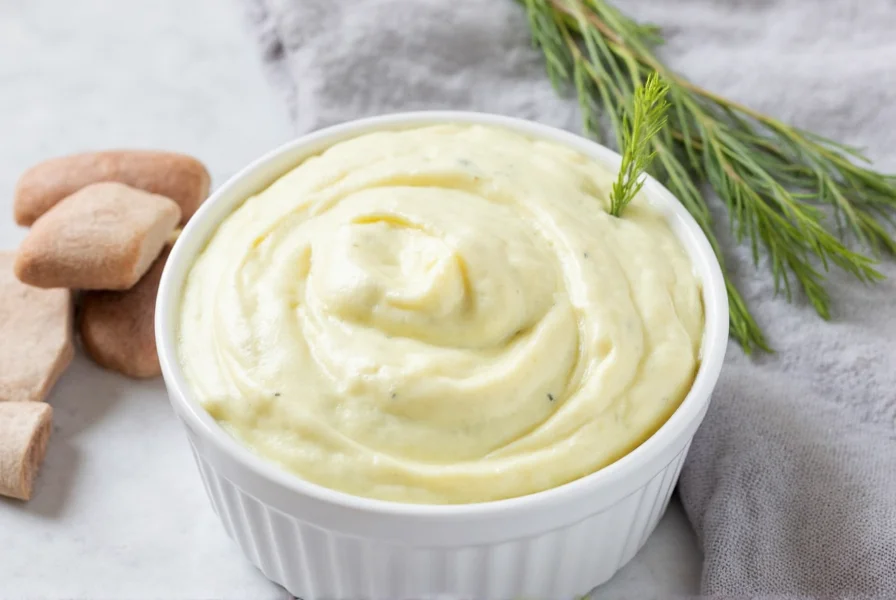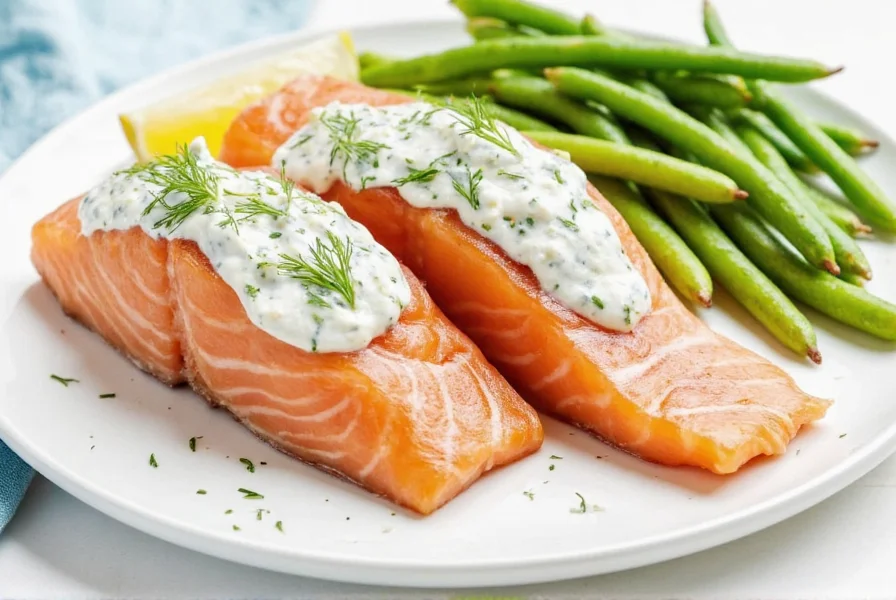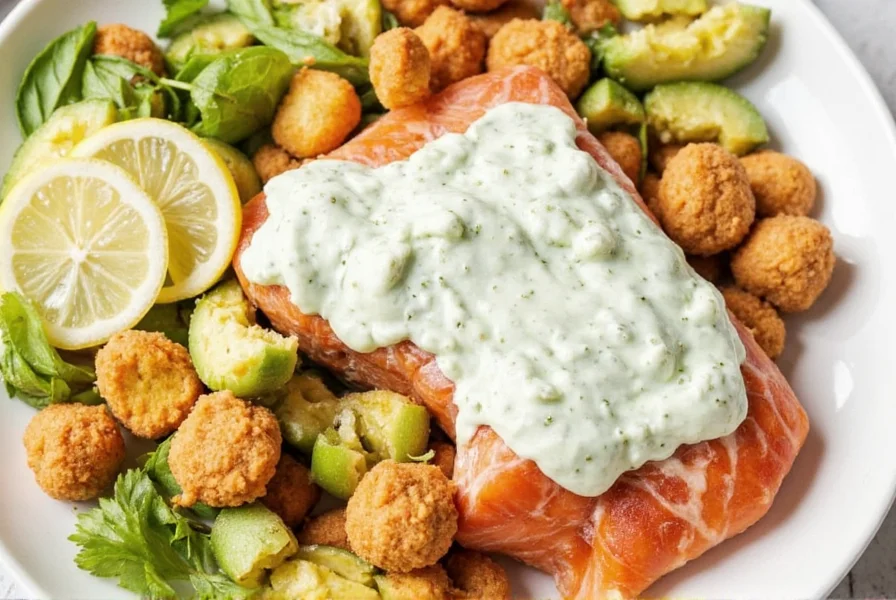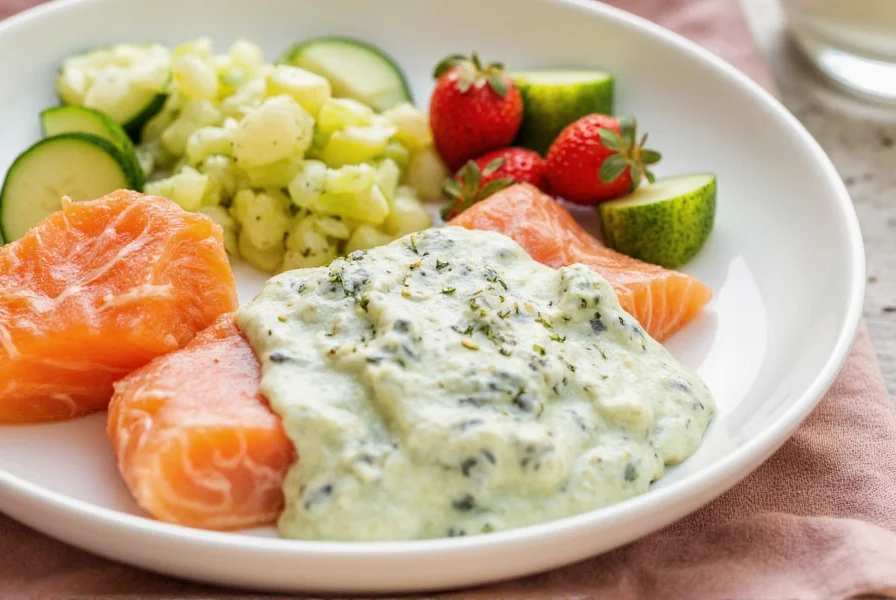Introduction: Why Dill Mayonnaise Elevates Salmon
Dill mayonnaise and salmon are a classic pairing that combines rich, buttery fish with bright, herbal notes. When prepared correctly, this combination creates a balanced dish perfect for grilling, baking, or serving cold. This guide focuses exclusively on salmon-specific applications of dill mayonnaise, with scientifically accurate food safety practices and professional culinary techniques.

Hack #1: Safe Storage for Salmon with Dill Mayo
When combining salmon and dill mayo, food safety is critical. Contrary to common myths, mayonnaise does not preserve salmon—it accelerates spoilage due to moisture transfer. Follow these guidelines:
- Never store salmon and mayonnaise together for more than 2 hours at room temperature
- Refrigerate immediately after preparation (below 40°F/4°C)
- Store components separately: keep salmon and mayo in different airtight containers
- Consume within 24 hours for optimal safety and texture
| Scenario | Storage Method | Max Safe Time |
|---|---|---|
| Raw salmon + mayo mixture | Refrigerated in sealed container | 24 hours |
| Cooked salmon + mayo | Refrigerated separately | 3 days |
| Room temperature exposure | Never leave unrefrigerated | 2 hours max |
Hack #2: Salmon-Specific Flavor Infusion
Enhance your dill mayo for salmon with these targeted combinations:
- Lemon zest + fresh dill + capers = classic Nordic pairing
- Smoked paprika + garlic powder = smoky depth for grilled salmon
- Horseradish + fresh dill = bold contrast for baked salmon
- White wine vinegar + tarragon = delicate balance for poached salmon

Hack #3: Perfect Texture for Salmon Applications
For salmon-specific mayo texture:
- Use high-quality egg yolks and avocado oil for stable emulsion
- Add 1 tsp lemon juice per 1/2 cup mayo to balance richness without overpowering salmon
- For glazes: Thin mayo with 1 tbsp olive oil to prevent burning during cooking
- For cold applications: Chill mayo for 30 minutes before mixing with salmon
Hack #4: Salmon-Specific Serving Applications
These techniques are designed exclusively for salmon dishes:
- Glaze: Brush lightly on salmon fillets during last 2 minutes of grilling
- Marinade: Marinate for 15-20 minutes max (longer causes texture breakdown)
- Salmon salad: Mix 1:1 ratio with flaked cooked salmon and diced celery
- Cold poached salmon: Serve chilled with dollop of dill mayo on side
Hack #5: Professional Grilling Technique
For perfect grilled salmon with dill mayo:
- Pat salmon dry before applying mayo to prevent steaming
- Apply mayo only to the top surface (not the skin side)
- Use medium-high heat (400°F/200°C) for 4-5 minutes per side
- Let rest 5 minutes before serving to allow flavors to meld
Hack #6: Meal Prep for Salmon Dishes
Safe meal prepping for salmon with dill mayo:
- Prepare salmon and mayo separately in airtight containers
- Store salmon in glass containers to prevent flavor transfer
- Keep mayo in small containers with plastic wrap pressed directly on surface
- Combine components only when ready to serve

Hack #7: Salmon-Specific Substitutions
For dietary needs while maintaining salmon pairing quality:
| Substitute | Best For | Salmon Pairing Tip |
|---|---|---|
| Vegan mayo | Dairy-free diets | Add 1/2 tsp lemon juice to compensate for missing tang |
| Full-fat Greek yogurt | Lower-calorie option | Mix with 1 tsp olive oil for better texture with salmon |
| Avocado-based spread | Healthy fat alternative | Use only for cold applications (not grilling) |
Hack #8: Sandwich Applications for Salmon
Professional salmon sandwich techniques:
- Use sourdough or rye bread for structural integrity
- Layer smoked salmon, dill mayo, and arugula
- Add thinly sliced red onion for crunch and contrast
- Place cucumber slices between layers to prevent sogginess
Hack #9: Balance Salmon's Richness
Perfect complementary elements for salmon with dill mayo:
- Acidic: Lemon wedges or pickled red onions
- Crisp: Cucumber ribbons or shaved fennel
- Earthy: Roasted beets or wild rice pilaf
- Herbal: Fresh dill sprigs and chives as garnish

Hack #10: Restaurant-Style Presentation
Elevate your salmon presentation with these techniques:
- Use squeeze bottle for precise dill mayo drizzling
- Place salmon on chilled plate for visual contrast
- Garnish with edible flowers and microgreens
- Pair with complementary side dishes in separate portions

Buying Guide: Salmon-Specific Ingredients
Mayonnaise Base for Salmon
| Product | Salmon Pairing Benefit | Best Cooking Method |
|---|---|---|
| Primal Kitchen Avocado Oil Mayo | High smoke point for grilling | Grilled or baked salmon |
| Heinz Real Mayonnaise | Classic flavor balance | Poached or cold salmon |
| Blue Plate Mayonnaise | Rich texture for salmon salad | Cold applications only |
Fresh Dill Selection Guide
| Type | Flavor Profile for Salmon | Best Use Case |
|---|---|---|
| Fresh dill (bunch) | Bright, grassy, aromatic | Raw applications and glazes |
| Dried dill (premium grade) | Earthy, concentrated | Marinades and baked salmon |
| Dill seed (ground) | Peppery, robust | Smoked salmon preparations |
Frequently Asked Questions: Salmon & Dill Mayo
How long can I safely store salmon with dill mayo?
For food safety, never combine salmon and mayonnaise until ready to serve. Store components separately: cooked salmon in airtight container (3 days refrigerated), mayonnaise with plastic wrap on surface (5 days). When combined, consume within 2 hours at room temperature or 24 hours refrigerated. The acid in mayonnaise does not preserve salmon—it accelerates moisture transfer that degrades texture.
Can I use dried dill for salmon dishes?
Yes, but use 1/3 the amount of dried dill versus fresh (e.g., 1 tsp dried for 1 tbsp fresh). Dried dill has earthier notes that work well with baked or smoked salmon. For grilled or poached salmon, fresh dill is preferred for brighter flavor. Always add dried dill to mayo 30 minutes before serving to allow rehydration.
What's the best way to apply dill mayo to grilled salmon?
Pat salmon dry, then apply thin layer of mayo only to the top surface during the last 2 minutes of grilling. Use medium-high heat (400°F/200°C) to prevent burning. For thicker fillets, apply half before cooking and half after for optimal crust and freshness. Never apply mayo at the beginning of cooking as it will burn and become bitter.
Can I marinate salmon in dill mayo?
Yes, but limit marinating time to 15-20 minutes maximum. The acid in mayonnaise will begin to "cook" the fish surface, creating a ceviche-like texture if left longer. For best results, pat salmon dry after marinating to ensure proper searing. Use only for thinner fillets (1/2 inch or less) to prevent texture issues.
What side dishes pair best with salmon and dill mayo?
Opt for sides that balance richness without overpowering: roasted asparagus with lemon zest, wild rice pilaf with dried cranberries, or cucumber-dill salad. Avoid heavy starches like mashed potatoes. For complete meals, pair with grilled vegetables and a light vinaigrette to complement the creamy mayo without competing flavors.
How to meal prep salmon with dill mayo safely?
Prepare components separately: cook salmon and store in glass container, make mayo in small container with plastic wrap on surface. Keep refrigerated at 38°F (3°C) or below. Combine only when ready to serve. For cold applications, freeze salmon in vacuum-sealed bags (up to 3 months) and thaw overnight in refrigerator before combining with mayo.
Conclusion: Master Salmon with Dill Mayo
By focusing exclusively on salmon-specific applications and following scientifically accurate food safety practices, you'll consistently create restaurant-quality dishes. Remember: proper ingredient separation, precise application techniques, and complementary pairings are key to elevating this classic combination. Whether grilling, baking, or serving cold, these techniques ensure perfect texture, flavor balance, and food safety every time.











 浙公网安备
33010002000092号
浙公网安备
33010002000092号 浙B2-20120091-4
浙B2-20120091-4